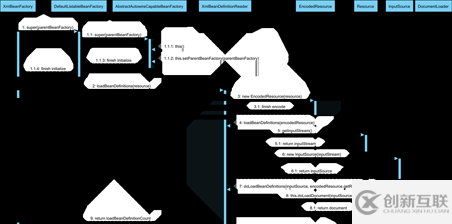詳解Spring簡單容器中的Bean基本加載過程
本篇將對定義在 XMl 文件中的 bean,從靜態的的定義到變成可以使用的對象的過程,即 bean 的加載和獲取的過程進行一個整體的了解,不去深究,點到為止,只求對 Spring IOC 的實現過程有一個整體的感知,具體實現細節留到后面用針對性的篇章進行講解。
創新互聯堅持“要么做到,要么別承諾”的工作理念,服務領域包括:做網站、成都網站建設、企業官網、英文網站、手機端網站、網站推廣等服務,滿足客戶于互聯網時代的靈壽網站設計、移動媒體設計的需求,幫助企業找到有效的互聯網解決方案。努力成為您成熟可靠的網絡建設合作伙伴!
首先我們來引入一個 Spring 入門使用示例,假設我們現在定義了一個類 org.zhenchao.framework.MyBean ,我們希望利用 Spring 來管理類對象,這里我們利用 Spring 經典的 XMl 配置文件形式進行配置:
<?xml version="1.0" encoding="UTF-8"?>
<beansxmlns="http://www.springframework.org/schema/beans"
xmlns:xsi="http://www.w3.org/2001/XMLSchema-instance"
xsi:schemaLocation="http://www.springframework.org/schema/beans http://www.springframework.org/schema/beans/spring-beans.xsd">
<!-- bean的基本配置 -->
<beanname="myBean"class="org.zhenchao.framework.MyBean"/>
</beans>
我們將上面的配置文件命名為 spring-core.xml,則對象的最原始的獲取和使用示例如下:
// 1. 定義資源
Resource resource = new ClassPathResource("spring-core.xml");
// 2. 利用XmlBeanFactory解析并注冊bean定義
XmlBeanFactory beanFactory = new XmlBeanFactory(resource);
// 3. 從IOC容器加載獲取bean
MyBean myBean = (MyBean) beanFactory.getBean("myBean");
// 4. 使用bean
myBean.sayHello();上面 demo 雖然簡單,但麻雀雖小,五臟俱全,完整的讓 Spring 執行了一遍配置文件加載,并獲取 bean 的過程。雖然從 Spring 3.1 開始 XmlBeanFactory 已經被置為 Deprecated ,但是 Spring 并沒有定義出更加高級的基于 XML 加載 bean 的 BeanFactory,而是推薦采用更加原生的方式,即組合使用 DefaultListableBeanFactory 和 XmlBeanDefinitionReader 來完成上訴過程:
Resource resource = new ClassPathResource("spring-core.xml");
DefaultListableBeanFactory beanFactory = new DefaultListableBeanFactory();
XmlBeanDefinitionReader reader = new XmlBeanDefinitionReader(beanFactory);
reader.loadBeanDefinitions(resource);
MyBean myBean = (MyBean) beanFactory.getBean("myBean");
myBean.sayHello();后面的分析你將會看到 XmlBeanFactory 實際上是對 DefaultListableBeanFactory 和 XmlBeanDefinitionReader 組合使用方式的封裝,所以這里我們仍然將繼續分析基于 XmlBeanFactory 加載 bean 的過程。
一. Bean的解析和注冊

Bean的加載過程,主要是對配置文件的解析,并注冊 bean 的過程,上圖是加載過程的時序圖,當我們 new XmlBeanFactory(resource) 的時候,已經完成將配置文件包裝成了 Spring 定義的資源,并觸發解析和注冊。 new XmlBeanFactory(resource) 調用的是下面的構造方法:
publicXmlBeanFactory(Resource resource)throwsBeansException{
this(resource, null);
}這個構造方法本質上還是繼續調用了:
publicXmlBeanFactory(Resource resource, BeanFactory parentBeanFactory)throwsBeansException{
super(parentBeanFactory);
// 加載xml資源
this.reader.loadBeanDefinitions(resource);
}在這個構造方法里面先是調用了父類構造函數,即 org.springframework.beans.factory.support.DefaultListableBeanFactory 類,這是一個非常核心的類,它包含了基本 IOC 容器所具有的重要功能,是一個 IOC 容器的基本實現。然后是調用了 this.reader.loadBeanDefinitions(resource) ,從這里開始加載配置文件。
Spring 在設計采用了許多程序設計的基本原則,比如迪米特法則、開閉原則,以及接口隔離原則等等,這樣的設計為后續的擴展提供了靈活性,也增強了模塊的復用性,這也是我看 Spring 源碼的動力之一,希望通過閱讀學習的過程來提升自己接口設計的能力。Spring 使用了專門的資源加載器對資源進行加載,這里的 reader 就是 org.springframework.beans.factory.xml.XmlBeanDefinitionReader 對象,專門用來加載基于 XML 文件配置的 bean。這里的加載過程為:
- 利用 EncodedResource 二次包裝資源文件
- 獲取資源輸入流,并構造 InputSource 對象
- 獲取 XML 文件的實體解析器和驗證模式
- 加載 XML 文件,獲取對應的 Document 對象
- 由 Document 對象解析并注冊 bean
1.利用 EncodedResource 二次包裝資源文件
采用 org.springframework.core.io.support.EncodedResource 對resource 進行二次封裝.
2.獲取資源輸入流,并構造 InputSource 對象
對資源進行編碼封裝之后,開始真正進入 this.loadBeanDefinitions(new EncodedResource(resource)) 的過程,該方法源碼如下:
publicintloadBeanDefinitions(EncodedResource encodedResource)throwsBeanDefinitionStoreException{
Assert.notNull(encodedResource, "EncodedResource must not be null");
if (logger.isInfoEnabled()) {
logger.info("Loading XML bean definitions from " + encodedResource.getResource());
}
// 標記正在加載的資源,防止循環引用
Set<EncodedResource> currentResources = this.resourcesCurrentlyBeingLoaded.get();
if (currentResources == null) {
currentResources = new HashSet<EncodedResource>(4);
this.resourcesCurrentlyBeingLoaded.set(currentResources);
}
if (!currentResources.add(encodedResource)) {
throw new BeanDefinitionStoreException("Detected cyclic loading of " + encodedResource + " - check your import definitions!");
}
try {
// 獲取資源的輸入流
InputStream inputStream = encodedResource.getResource().getInputStream();
try {
// 構造InputSource對象
InputSource inputSource = new InputSource(inputStream);
if (encodedResource.getEncoding() != null) {
inputSource.setEncoding(encodedResource.getEncoding());
}
// 真正開始從XML文件中加載Bean定義
return this.doLoadBeanDefinitions(inputSource, encodedResource.getResource());
} finally {
inputStream.close();
}
} catch (IOException ex) {
throw new BeanDefinitionStoreException("IOException parsing XML document from " + encodedResource.getResource(), ex);
} finally {
currentResources.remove(encodedResource);
if (currentResources.isEmpty()) {
this.resourcesCurrentlyBeingLoaded.remove();
}
}
}
需要知曉的是 org.xml.sax.InputSource 不是 Spring 中定義的類,這個類來自 jdk,是 java 對 XML 實體提供的原生支持。這個方法主要還是做了一些準備工作,按照 Spring 方法的命名相關,真正干活的方法一般都是以 “do” 開頭的,這里的 this.doLoadBeanDefinitions(inputSource, encodedResource.getResource()) 就是真正開始加載 XMl 的入口,該方法源碼如下:
protectedintdoLoadBeanDefinitions(InputSource inputSource, Resource resource)throwsBeanDefinitionStoreException{
try {
// 1. 加載xml文件,獲取到對應的Document(包含獲取xml文件的實體解析器和驗證模式)
Document doc = this.doLoadDocument(inputSource, resource);
// 2. 解析Document對象,并注冊bean
return this.registerBeanDefinitions(doc, resource);
} catch (BeanDefinitionStoreException ex) {
// 這里是連環catch,省略
}
}
方面里面的邏輯還是很清晰的,第一步獲取 org.w3c.dom.Document 對象,第二步由該對象解析得到 BeanDefinition 對象,并注冊到 IOC 容器中。
3.獲取 XML 文件的實體解析器和驗證模式
this.doLoadDocument(inputSource, resource) 包含了獲取實體解析器、驗證模式,以及 Document 對象的邏輯,源碼如下:
protectedDocumentdoLoadDocument(InputSource inputSource, Resource resource)throwsException{
return this.documentLoader.loadDocument(
inputSource,
this.getEntityResolver(), // 獲取實體解析器
this.errorHandler,
this.getValidationModeForResource(resource), // 獲取驗證模式
this.isNamespaceAware());
}
XML 是半結構化數據,XML 的驗證模式用于保證結構的正確性,常見的驗證模式有 DTD 和 XSD 兩種,獲取驗證模式的源碼如下:
protectedintgetValidationModeForResource(Resource resource){
int validationModeToUse = this.getValidationMode();
if (validationModeToUse != VALIDATION_AUTO) {
// 手動指定了驗證模式
return validationModeToUse;
}
// 沒有指定驗證模式,則自動檢測
int detectedMode = this.detectValidationMode(resource);
if (detectedMode != VALIDATION_AUTO) {
return detectedMode;
}
// 檢測驗證模式失敗,默認采用XSD驗證
return VALIDATION_XSD;
}
上面源碼描述了獲取驗證模式的執行流程,如果沒有手動指定,那么 Spring 會去自動檢測。對于 XML 文件的解析,SAX 首先會讀取 XML 文件頭聲明,以獲取對應驗證文件地址,并下載對應的文件,如果網絡不正常,則會影響下載過程,這個時候可以通過注冊一個實體解析來實現尋找驗證文件的過程。
4.加載 XML 文件,獲取對應的 Document 對象
獲取對應的驗證模式和解析器,解析去就可以加載 Document 對象了,這里本質上調用的是 org.springframework.beans.factory.xml.DefaultDocumentLoader 的 loadDocument() 方法,源碼如下:
publicDocumentloadDocument(InputSource inputSource, EntityResolver entityResolver,
ErrorHandler errorHandler, int validationMode, boolean namespaceAware) throws Exception {
DocumentBuilderFactory factory = this.createDocumentBuilderFactory(validationMode, namespaceAware);
if (logger.isDebugEnabled()) {
logger.debug("Using JAXP provider [" + factory.getClass().getName() + "]");
}
DocumentBuilder builder = this.createDocumentBuilder(factory, entityResolver, errorHandler);
return builder.parse(inputSource);
}
整個過程類似于我們平常解析 XML 文件的流程。
5.由 Document 對象解析并注冊 bean
完成了對 XML 文件的到 Document 對象的解析,我們終于可以解析 Document 對象,并注冊 bean 了,這一過程發生在 this.registerBeanDefinitions(doc, resource) 中,源碼如下:
publicintregisterBeanDefinitions(Document doc, Resource resource)throwsBeanDefinitionStoreException{
// 使用DefaultBeanDefinitionDocumentReader構造
BeanDefinitionDocumentReader documentReader = this.createBeanDefinitionDocumentReader();
// 記錄之前已經注冊的BeanDefinition個數
int countBefore = this.getRegistry().getBeanDefinitionCount();
// 加載并注冊bean
documentReader.registerBeanDefinitions(doc, createReaderContext(resource));
// 返回本次加載的bean的數量
return getRegistry().getBeanDefinitionCount() - countBefore;
}
這里方法的作用是創建對應的 BeanDefinitionDocumentReader,并計算返回了過程中新注冊的 bean 的數量,而具體的注冊過程,則是由 BeanDefinitionDocumentReader 來完成的,具體的實現位于子類 DefaultBeanDefinitionDocumentReader 中:
publicvoidregisterBeanDefinitions(Document doc, XmlReaderContext readerContext){
this.readerContext = readerContext;
logger.debug("Loading bean definitions");
// 獲取文檔的root結點
Element root = doc.getDocumentElement();
this.doRegisterBeanDefinitions(root);
}
還是按照 Spring 命名習慣,doRegisterBeanDefinitions 才是真正干活的地方,這也是真正開始解析配置的核心所在:
protectedvoiddoRegisterBeanDefinitions(Element root){
BeanDefinitionParserDelegate parent = this.delegate;
this.delegate = this.createDelegate(getReaderContext(), root, parent);
if (this.delegate.isDefaultNamespace(root)) {
// 處理profile標簽(其作用類比pom.xml中的profile)
String profileSpec = root.getAttribute(PROFILE_ATTRIBUTE);
if (StringUtils.hasText(profileSpec)) {
String[] specifiedProfiles =
StringUtils.tokenizeToStringArray(profileSpec, BeanDefinitionParserDelegate.MULTI_VALUE_ATTRIBUTE_DELIMITERS);
if (!this.getReaderContext().getEnvironment().acceptsProfiles(specifiedProfiles)) {
if (logger.isInfoEnabled()) {
logger.info("Skipped XML bean definition file due to specified profiles [" + profileSpec + "] not matching: " + getReaderContext().getResource());
}
return;
}
}
}
// 解析預處理,留給子類實現
this.preProcessXml(root);
// 解析并注冊BeanDefinition
this.parseBeanDefinitions(root, this.delegate);
// 解析后處理,留給子類實現
this.postProcessXml(root);
this.delegate = parent;
}
方法中顯示處理了 標簽,這個屬性在 Spring 中不是很常用,不過在 maven 的 pom.xml 中則很常見,意義也是相同的,就是配置多套環境,從而在部署的時候可以根據具體環境來選擇使用哪一套配置。方法中會先去檢測是否配置了 profile,如果配置了就需要從上下文環境中確認當前激活了哪一套 profile。
方法在解析并注冊 BeanDefinition 前后各設置一個模板方法,留給子類擴展實現,而在 this.parseBeanDefinitions(root, this.delegate) 中執行解析和注冊邏輯:
protectedvoidparseBeanDefinitions(Element root, BeanDefinitionParserDelegate delegate){
if (delegate.isDefaultNamespace(root)) {
// 解析默認標簽
NodeList nl = root.getChildNodes();
for (int i = 0; i < nl.getLength(); i++) {
Node node = nl.item(i);
if (node instanceof Element) {
Element ele = (Element) node;
if (delegate.isDefaultNamespace(ele)) {
// 解析默認標簽
this.parseDefaultElement(ele, delegate);
} else {
// 解析自定義標簽
delegate.parseCustomElement(ele);
}
}
}
} else {
// 解析自定義標簽
delegate.parseCustomElement(root);
}
}方法中判斷當前標簽是默認標簽還是自定義標簽,并按照不同的策略去解析,這是一個復雜的過程,后面用文章進行針對性講解,這里不在往下細究。
到這里我們已經完成了靜態配置到動態 BeanDefinition 的解析,這個時候 bean 的定義已經處于內存中,解析去將是探究如何獲取并使用 bean 的過程。
二. Bean的獲取
在完成了 Bean 的加載過程之后,我們可以調用 beanFactory.getBean("myBean") 方法來獲取目標對象,這里本質上調用的是 org.springframework.beans.factory.support.AbstractBeanFactory 的 getBean() 方法,源碼如下:
publicObjectgetBean(String name)throwsBeansException{
return this.doGetBean(name, null, null, false);
}這里調用 this.doGetBean(name, null, null, false) 來實現具體邏輯,也符合我們的預期,該方法可以看做是獲取 bean 的整體框架,一個函數完成了整個過程的模塊調度,還是挺復雜的:
protected <T> TdoGetBean(
final String name, final Class<T> requiredType, final Object[] args, boolean typeCheckOnly) throws BeansException {
/*
* 轉化對應的beanName
*
* 傳入的參數可能是alias,也可能是FactoryBean,所以需要進行解析,主要包含以下內容:
* 1. 去除FactoryBean的修飾符“&”
* 2. 取指定alias對應的最終的name
*/
final String beanName = this.transformedBeanName(name);
Object bean;
/*
* 檢查緩存或者實例工廠中是否有對應的實例
*
* 為什么會一開始就進行檢查?
* 因為在創建單例bean的時候會存在依賴注入的情況,而在創建依賴的時候為了避免循環依賴
* Spring創建bean的原則是不等bean創建完成就會將創建bean的ObjectFactory提前曝光,即將對應的ObjectFactory加入到緩存
* 一旦下一個bean創建需要依賴上一個bean,則直接使用ObjectFactory
*/
Object sharedInstance = this.getSingleton(beanName); // 獲取單例
if (sharedInstance != null && args == null) {
// 實例已經存在
if (logger.isDebugEnabled()) {
if (this.isSingletonCurrentlyInCreation(beanName)) {
logger.debug("Returning eagerly cached instance of singleton bean '" + beanName + "' that is not fully initialized yet - a consequence of a circular reference");
} else {
logger.debug("Returning cached instance of singleton bean '" + beanName + "'");
}
}
// 返回對應的實例
bean = this.getObjectForBeanInstance(sharedInstance, name, beanName, null);
} else {
// 單例實例不存在
if (this.isPrototypeCurrentlyInCreation(beanName)) {
/*
* 只有在單例模式下才會嘗試解決循環依賴問題
* 對于原型模式,如果存在循環依賴,也就是滿足this.isPrototypeCurrentlyInCreation(beanName),拋出異常
*/
throw new BeanCurrentlyInCreationException(beanName);
}
BeanFactory parentBeanFactory = this.getParentBeanFactory();
if (parentBeanFactory != null && !this.containsBeanDefinition(beanName)) {
// 如果在beanDefinitionMap中(即所有已經加載的類中)不包含目標bean,則嘗試從parentBeanFactory中檢測
String nameToLookup = this.originalBeanName(name);
if (args != null) {
// 遞歸到BeanFactory中尋找
return (T) parentBeanFactory.getBean(nameToLookup, args);
} else {
return parentBeanFactory.getBean(nameToLookup, requiredType);
}
}
// 如果不僅僅是做類型檢查,則創建bean
if (!typeCheckOnly) {
this.markBeanAsCreated(beanName);
}
try {
/*
* 將存儲XML配置的GenericBeanDefinition轉換成RootBeanDefinition
* 如果指定了beanName是子bean的話,同時會合并父類的相關屬性
*/
final RootBeanDefinition mbd = this.getMergedLocalBeanDefinition(beanName);
this.checkMergedBeanDefinition(mbd, beanName, args);
// 獲取當前bean依賴的bean
String[] dependsOn = mbd.getDependsOn();
if (dependsOn != null) {
// 存在依賴,遞歸實例化依賴的bean
for (String dep : dependsOn) {
if (this.isDependent(beanName, dep)) {
throw new BeanCreationException(mbd.getResourceDescription(), beanName, "Circular depends-on relationship between '" + beanName + "' and '" + dep + "'");
}
// 緩存依賴調用
this.registerDependentBean(dep, beanName);
this.getBean(dep);
}
}
// 實例化依賴的bean后,實例化mbd自身
if (mbd.isSingleton()) {
// scope == singleton
sharedInstance = this.getSingleton(beanName, new ObjectFactory<Object>() {
@Override
publicObjectgetObject()throwsBeansException{
try {
return createBean(beanName, mbd, args);
} catch (BeansException ex) {
// Explicitly remove instance from singleton cache: It might have been put there
// eagerly by the creation process, to allow for circular reference resolution.
// Also remove any beans that received a temporary reference to the bean.
destroySingleton(beanName);
throw ex;
}
}
});
bean = this.getObjectForBeanInstance(sharedInstance, name, beanName, mbd);
} else if (mbd.isPrototype()) {
// scope == prototype
Object prototypeInstance;
try {
this.beforePrototypeCreation(beanName);
prototypeInstance = this.createBean(beanName, mbd, args);
} finally {
this.afterPrototypeCreation(beanName);
}
// 返回對應的實例
bean = this.getObjectForBeanInstance(prototypeInstance, name, beanName, mbd);
} else {
// 其它scope
String scopeName = mbd.getScope();
final Scope scope = this.scopes.get(scopeName);
if (scope == null) {
throw new IllegalStateException("No Scope registered for scope name '" + scopeName + "'");
}
try {
Object scopedInstance = scope.get(beanName, new ObjectFactory<Object>() {
@Override
publicObjectgetObject()throwsBeansException{
beforePrototypeCreation(beanName);
try {
return createBean(beanName, mbd, args);
} finally {
afterPrototypeCreation(beanName);
}
}
});
// 返回對應的實例
bean = this.getObjectForBeanInstance(scopedInstance, name, beanName, mbd);
} catch (IllegalStateException ex) {
throw new BeanCreationException(beanName, "Scope '" + scopeName + "' is not active for the current thread; consider defining a scoped proxy for this bean if you intend to refer to it from a singleton", ex);
}
}
} catch (BeansException ex) {
cleanupAfterBeanCreationFailure(beanName);
throw ex;
}
}
// 檢查需要的類型是否符合bean的實際類型,對應getBean時指定的requireType
if (requiredType != null && bean != null && !requiredType.isAssignableFrom(bean.getClass())) {
try {
return this.getTypeConverter().convertIfNecessary(bean, requiredType);
} catch (TypeMismatchException ex) {
if (logger.isDebugEnabled()) {
logger.debug("Failed to convert bean '" + name + "' to required type '" + ClassUtils.getQualifiedName(requiredType) + "'", ex);
}
throw new BeanNotOfRequiredTypeException(name, requiredType, bean.getClass());
}
}
return (T) bean;
}
以上就是本文的全部內容,希望對大家的學習有所幫助,也希望大家多多支持創新互聯。
分享文章:詳解Spring簡單容器中的Bean基本加載過程
文章URL:http://newbst.com/article22/jocdjc.html
成都網站建設公司_創新互聯,為您提供品牌網站建設、建站公司、企業建站、做網站、品牌網站設計、搜索引擎優化
聲明:本網站發布的內容(圖片、視頻和文字)以用戶投稿、用戶轉載內容為主,如果涉及侵權請盡快告知,我們將會在第一時間刪除。文章觀點不代表本網站立場,如需處理請聯系客服。電話:028-86922220;郵箱:631063699@qq.com。內容未經允許不得轉載,或轉載時需注明來源: 創新互聯

- 企業網站制作完成后要經常更新網站內容 2021-12-09
- 企業網站制作收錄不好的原因 2016-03-28
- 企業網站制作和企業發展有什么關系? 2016-09-06
- 企業網站制作存在的問題有哪些?如何解決 2016-09-15
- 茂名公司網站建設:你知道如何進行企業網站制作嗎? 2021-10-21
- 北京企業網站制作完成后該如何為引流? 2023-03-23
- 企業網站制作如何做實際效果會更強? 2023-04-10
- 企業網站制作找創新互聯,你無需再去第二家 2022-05-11
- 普通企業網站制作如何宣傳讓客戶輕松找到你 2013-05-15
- 企業網站制作必須關注的常識及應該確定的目標 2021-10-02
- 企業網站制作應該遵循那些原則呢? 2016-10-29
- 企業網站制作如何選擇服務商 2021-10-10